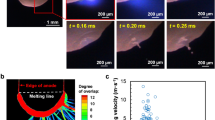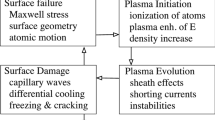Abstract
THE total potential across a short arc discharge is normally a few tens of volts, and the cathode and anode falls, the regions of high field close to the electrodes, account for a large proportion of this. The small thickness and high current density in the cathode and anode fall sheaths make measurements of potential in these regions very difficult. In the past, the sum of the electrode potential falls has been found either by extrapolating voltage-length plots to zero length, or by measuring the arc voltage on an oscilloscope just before approaching electrodes contact1, but it has not been possible to determine their individual contributions unambiguously. The thickness of these regions has also remained a matter of conjecture.
This is a preview of subscription content, access via your institution
Access options
Subscribe to this journal
Receive 51 print issues and online access
$199.00 per year
only $3.90 per issue
Buy this article
- Purchase on Springer Link
- Instant access to full article PDF
Prices may be subject to local taxes which are calculated during checkout
Similar content being viewed by others
References
von Engel, A., Ionised Gases, second ed., 274 (Oxford Univ. Press, 1965).
von Engel, A., and Robson, A. E., Proc. Roy. Soc., A, 242, 217 (1957).
Author information
Authors and Affiliations
Rights and permissions
About this article
Cite this article
DICKSON, D. Cathode Region of a Vapour Arc. Nature 212, 64–65 (1966). https://doi.org/10.1038/212064a0
Issue Date:
DOI: https://doi.org/10.1038/212064a0
Comments
By submitting a comment you agree to abide by our Terms and Community Guidelines. If you find something abusive or that does not comply with our terms or guidelines please flag it as inappropriate.



